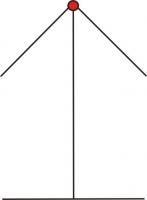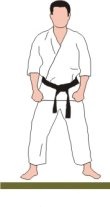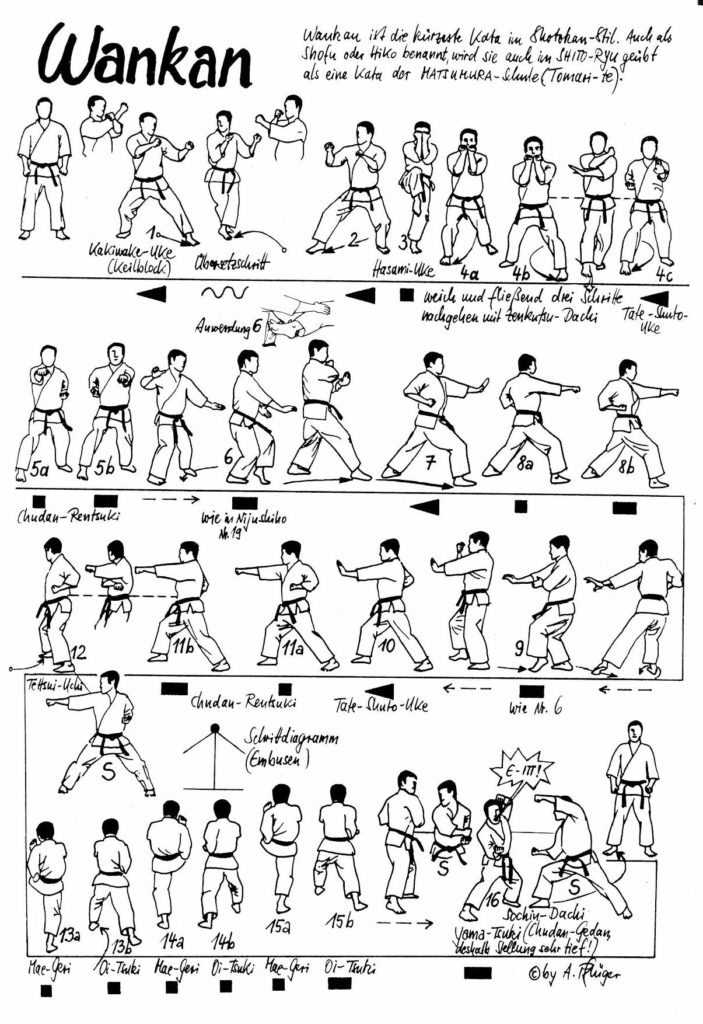Wankan, or "King's Crown," gets its name from the kata's first six moves, which are supposed to form the shape of a crown. When viewing this crown shape, one must appreciate that Wankan is the only Shotokan kata that begins diagonally. Some historians claim Wankan was handed down by the Okinawan royal family, thereby getting its name. As with other kata, Gichin Funakoshi tried to change its Okinawan name to a Japanese one. The names Shofu (Pine Wind) and Hito (Flying Waves) were attempted but failed. Wankan is one of the more recent additions to the Shotokan repertoire, possibly being imported and modified from another style (as with most of the advanced kata) by Yoshitaka Funakoshi. Wankan is a very short kata having only 24 counts and only 1 kiai, leading some karate enthusiasts to the conclusion that the kata's transition to Shotokan was never fully completed due to Yoshitaka Funakoshi's untimely death. Generally, the movements of Wankando not pose too much difficulty for the practitioner. Moves four and five, although unusual, are not very taxing; in fact, they are even liberating because they are not confined by any stance. The only potentially troublesome technique occurs during #13, when turning from zenkutsu-dachi into neko-ashi-dachi. Although, on the surface, it is a simple mawate (turn), it is quite difficult to perform koko-sukui/koko-tsukidashi quickly, with balance and power. Overall, Wankan is a very fluid and low impact kata, having some very puzzling bunkai. It is not a very popular exam or tournament kata.
Wankan (along with Jiin) is probably one of the least practiced kata in Shotokan dojo. Why? Probably of greatest significance, Wankan (along with Jiin) was never documented in Masatoshi Nakayama's Best Karate series, a karateka's number one resource for Shotokan kata. If this exclusion didn't lend itself to the allusion of Wankan's lack of significance, at the very least, it certainly reinforced neglect of the kata. As a late addition to the compendium of JKA kata, Wankan simply hasn't received as much attention as its predecessors. The JKA has taken steps to increase awareness of this kata by including Wankan in their modernised series of books titled Karate-Do Kata.
Wankan
King's Crown
Wankan
King's Crown
Some of the Key Moves:
- Neko-ashi dachi (cat stance)
- Hasami-uke (scizzors block)
- Koko-sukui/koko-tsukidashi (tiger-mouth scooping block /tiger-mouth thrust)
- Yama-tsuki (mountain punch)
Embusen of kata

the kata in practice
In position musubi-dachi.
Advertise the " Wankan " kata .
Yoi: In position hachiji-dachi . The fists are in front of the hips.
1. Chudan kakiwake-uke :
( 1A ) Turn the head to the left, advance the right foot in front of the left foot in the same direction, while raising the fists by joining them in front of the chest, fists facing upwards, right fist towards the bust.
( 1B ) Without moving your arms, move your left foot 45 degrees to the left to find yourself in the neko-ashi-dachi position.
( 1C ) Complete the movement of the arms to execute a medium level separator block (kakiwake-uke ).
2. Chudan kakiwake-uke :
( 2A ) Without changing the position of the arms, turn the head to the right, advance the left foot in front of the right foot in the same direction.
( 2B ) Advance the right foot at an angle of 45 ° to the right to find yourself in the position neko-ashi-dachi. Join the fists in front of the chest, fists facing upwards, left fist towards the bust.
( 2C ) Finish arm movement to execute medium level separator block ( kakiwake-uke ).
3. Muso-uke = Hasami-uke / Hiza-kamae : Turn your head to the left to look ahead.Join the arms in front of the chest to perform a scissor bite ( hasami-uke ), while raising the right knee in front of you, toes down in hiza-kamae posture .
4. Hidari chudan gyaku tate shuto-uke :
( 4A ) Without changing the position of the arms, advance the right foot in front of the left foot, about 1 foot length.
( 4B ) Without changing the position of the arms, advance the left foot in front of the right foot, approximately 1 foot length.
( 4C ) Advance the right foot in front of the left foot, open the left hand and arm there to the right side of the body.
( 4D ) Sit in the zenkutsu-dachi position while performing an inverted vertical blocking of the mid-level left ( gyaku tate shuto-uke ).
5. Chudan jun-zuki / Hidari chudan gyaku-zuki migi : On the spot, always in zenkutsu-dachi position, wear a right middle level ( jun-zuki ) right punch , followed by a left inverted left hand punch ( gyaku-zuki )
6. Koko hiza-kuzushi :
( 6A ) Turn your head to the left, advance your left foot by swiveling the pelvis to the left to find yourself in the neko-ashi-dachi position. Simultaneously, extend the left arm to the left by opening your hand.
( 6B ) Bring your left hand to the abdomen to make a "spoon" block, while you lower your right hand to perform an imbalance by pushing the knee opponent ( koko hiza-kuzushi ) = "imbalance in mouth" tiger ".
7. Hidari chudan gyaku tate shuto-uke :
( 7A ) Advance the right foot while extending the right arm in front of you keeping the left hand in front of the right side.
( 7B ) Sit in the zenkutsu-dachi position while performing an inverted vertical blocking of the mid-level left ( gyaku tate shuto-uke ).
8. Chudan jun-zuki / Hidari chudan gyaku-zuki migi : On the spot, always in zenkutsu-dachi position , carry a right middle level ( jun-zuki ) right punch , followed by a left inverted left hand punch ( gyaku-zuki )
9. Koko hiza-kuzushi :
( 9A ) Turn the head to the left, shift the left foot in your back by swiveling the pelvis 180 ° to the left to find yourself in the position neko-ashi-dachi. Simultaneously, extend the open left hand in the same direction along a circular path.
( 9B ) Bring your left hand to the abdomen to make a "spoon" block, as well as you perform a thrust imbalance of the right hand on the opponent's knee ( koko hiza-kuzushi ).
10. Hidari chudan gyaku tate shuto-uke :
( 10A ) Advance the right foot while extending the right arm in front of you keeping the left hand in front of the right side.
( 10B ) Sit in the zenkutsu-dachi position while performing an inverted vertical blocking of the mid-level left hand ( gyaku tate shuto-uke ).
11. Migi chudan jun-zuki / Hidari chudan gyaku-zuki : On the spot, always in zenkutsu-dachi position , wear a right middle level ( jun-zuki ) right punch , followed by a left inverted left hand punch ( gyaku-zuki )
12. Migi tettsui-uchi : Turn the head to the right, move the right foot back to align with the left foot and shift it to the right to find yourself in the kiba-dachi position.Simultaneously, arm the right fist under the left armpit and send it to the right for a right hammer ( tettsui-uchi ).
13. Hidari mae-geri / Hidari jun-zuki : Swivel the pelvis to the right to send a left-lashed frontal kick in the direction of the hammer ( mae-geri )punch. Rest your left foot in zenkutsu-dachi position at the same time as you are wearing a left-front ( jun-zuki ) punch .
14. Migi mae-geri / Migi jun-zuki : Strike a right whipped frontal kick (mae-geri). Rest the right foot in front of you in zenkutsu-dachi position at the same time as you are wearing a right front ( jun-zuki ) punch .
15. Hidari mae-geri / Hidari jun-zuki : Make a left whipped frontal kick ( mae-geri ).Rest your left foot in zenkutsu-dachi position at the same time as you are wearing a left-front ( jun-zuki ) punch .
16. Yama-zuki : Turn the head to the right to look in the opposite direction, shift the right foot to the other side in your back in fudo-dachi position, and bring the 2 fists to the left hip. Wear a large double U -shaped punch in front of you ( yama-zuki ). The left fist is aimed at the face of the opponent and the right fist is aimed at the abdomen. At the finish of the technique, the 2 fists must be on a vertical axis.
KIAÏ !!!

Yame : Retreat the left foot before shifting it to the left to align with the right foot in the heisoku-dachi position . Bring your fists to the hips.







